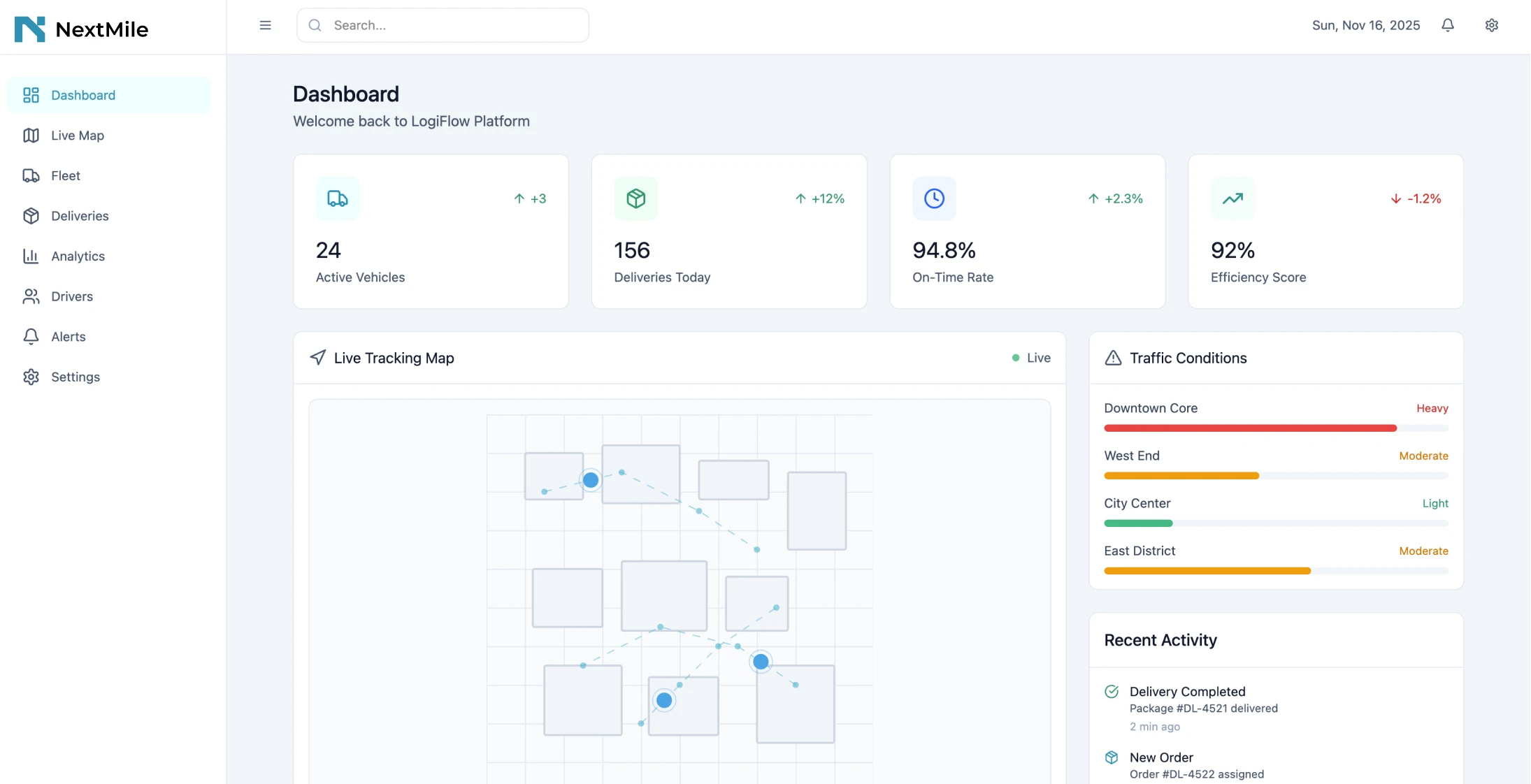
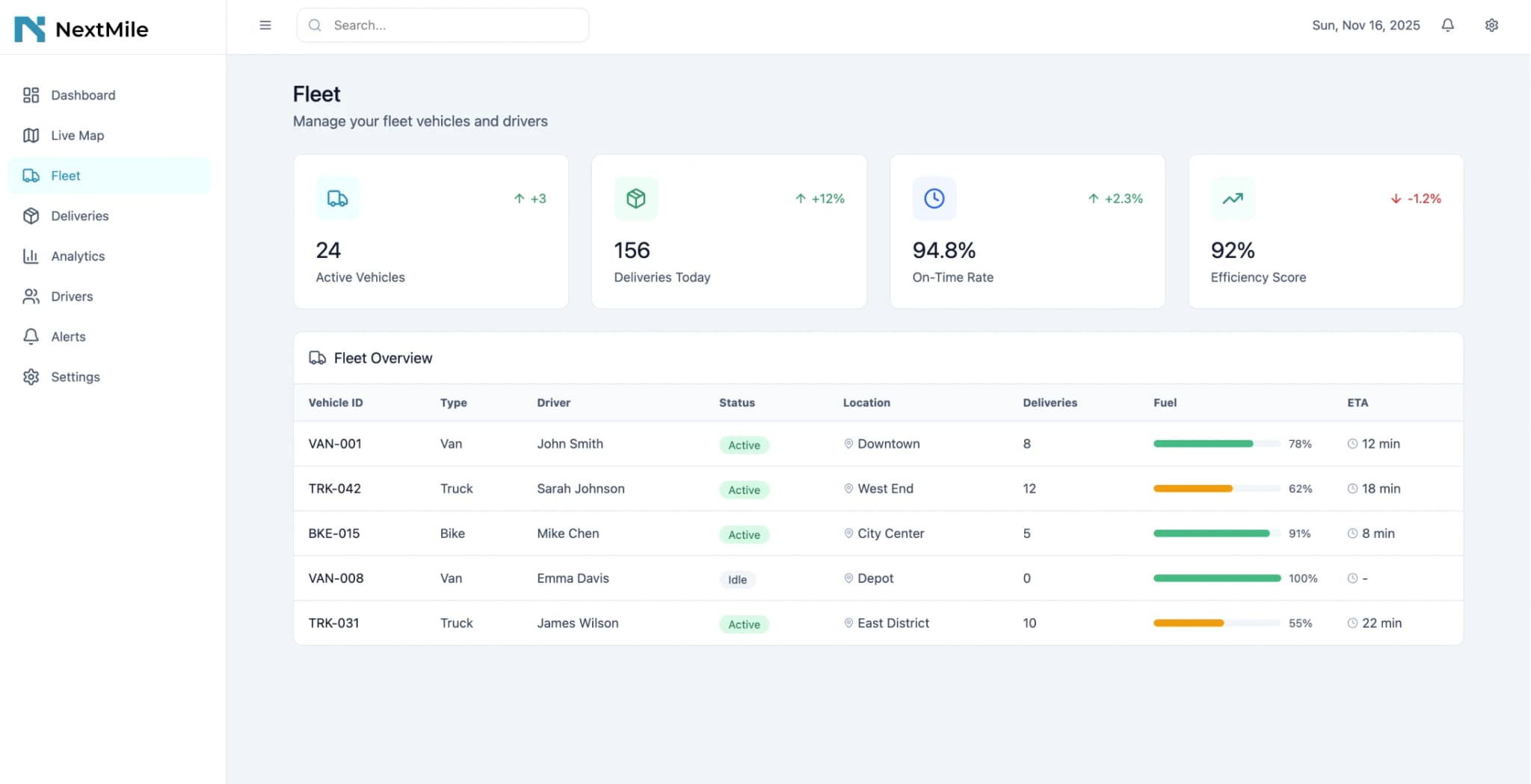
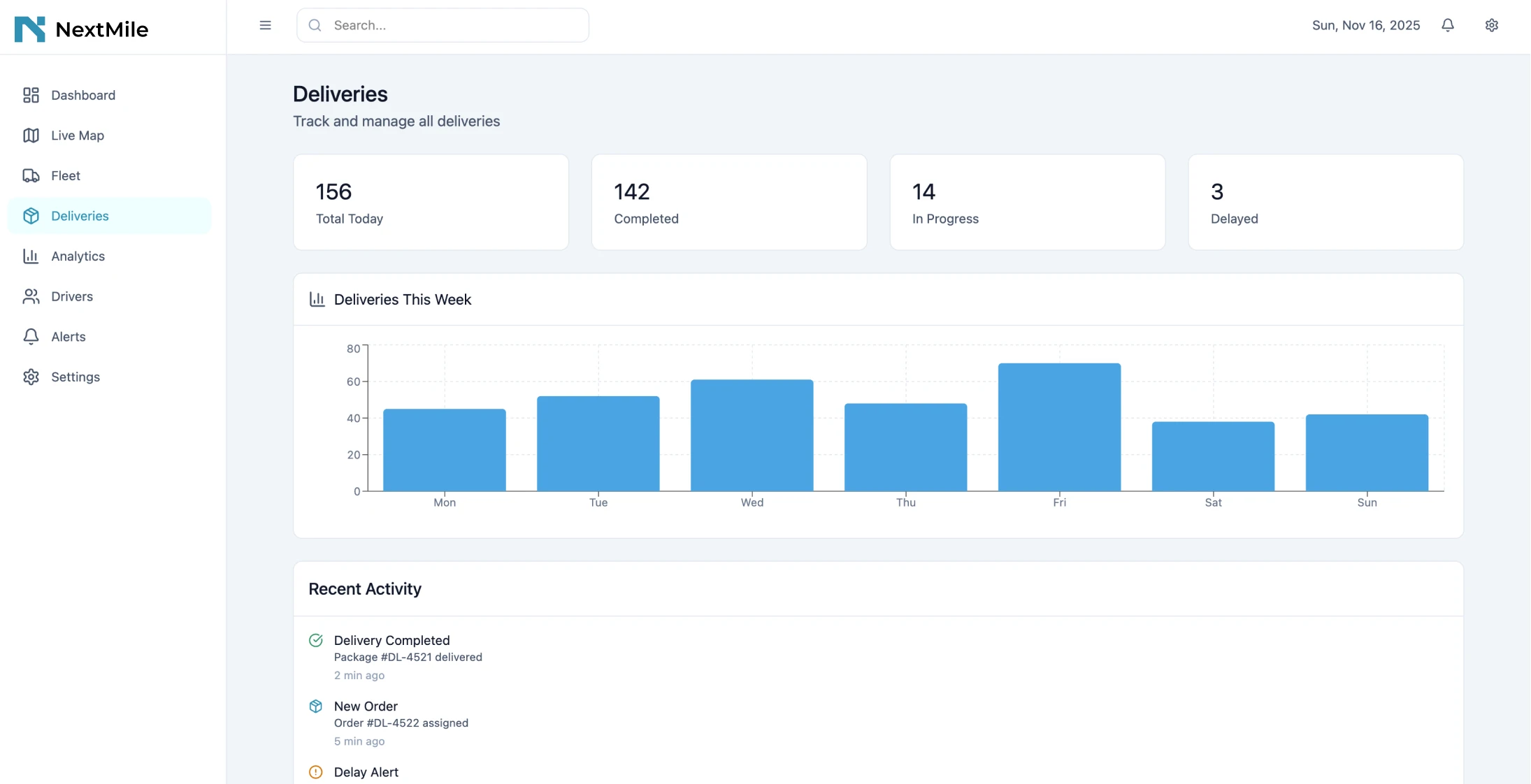
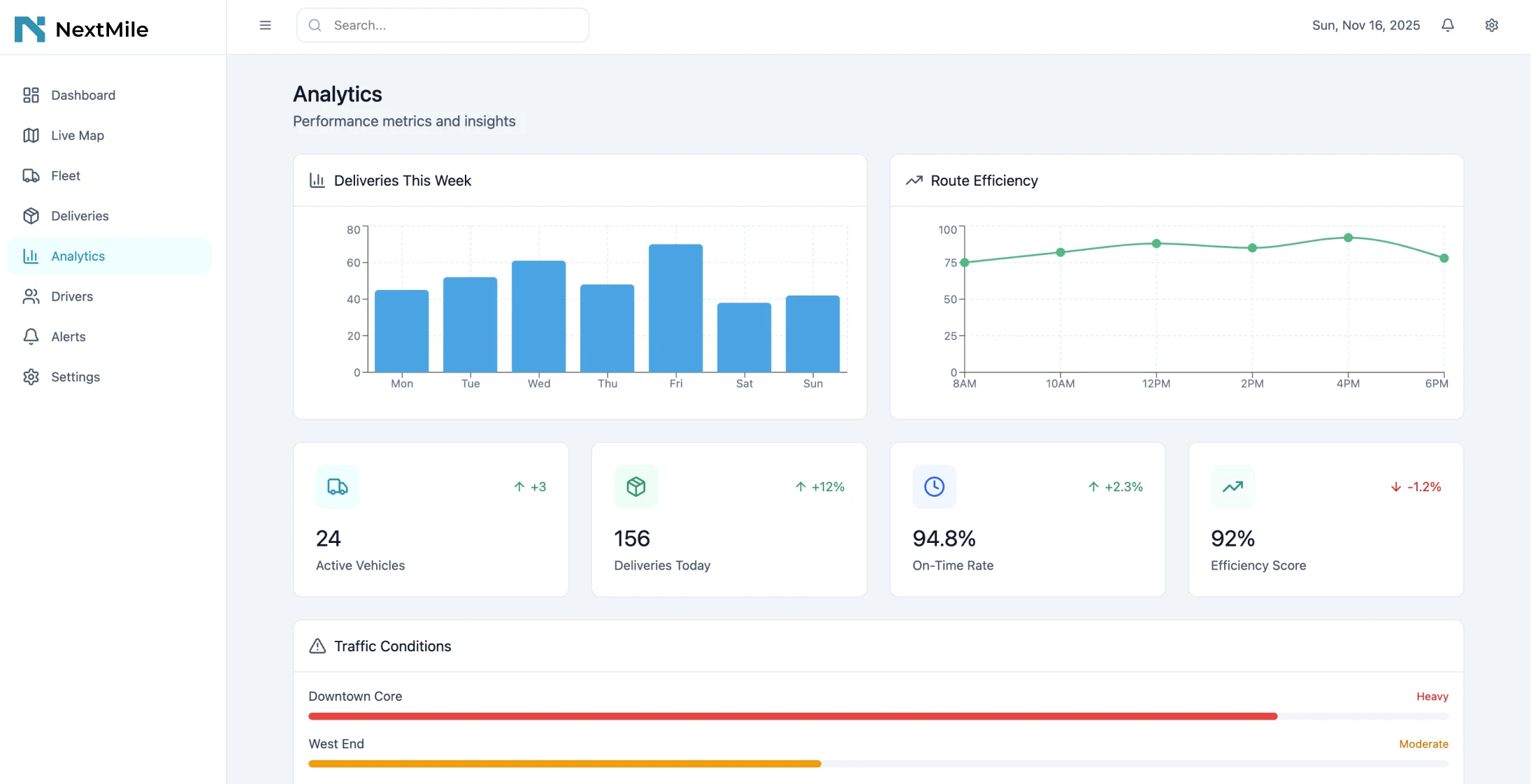
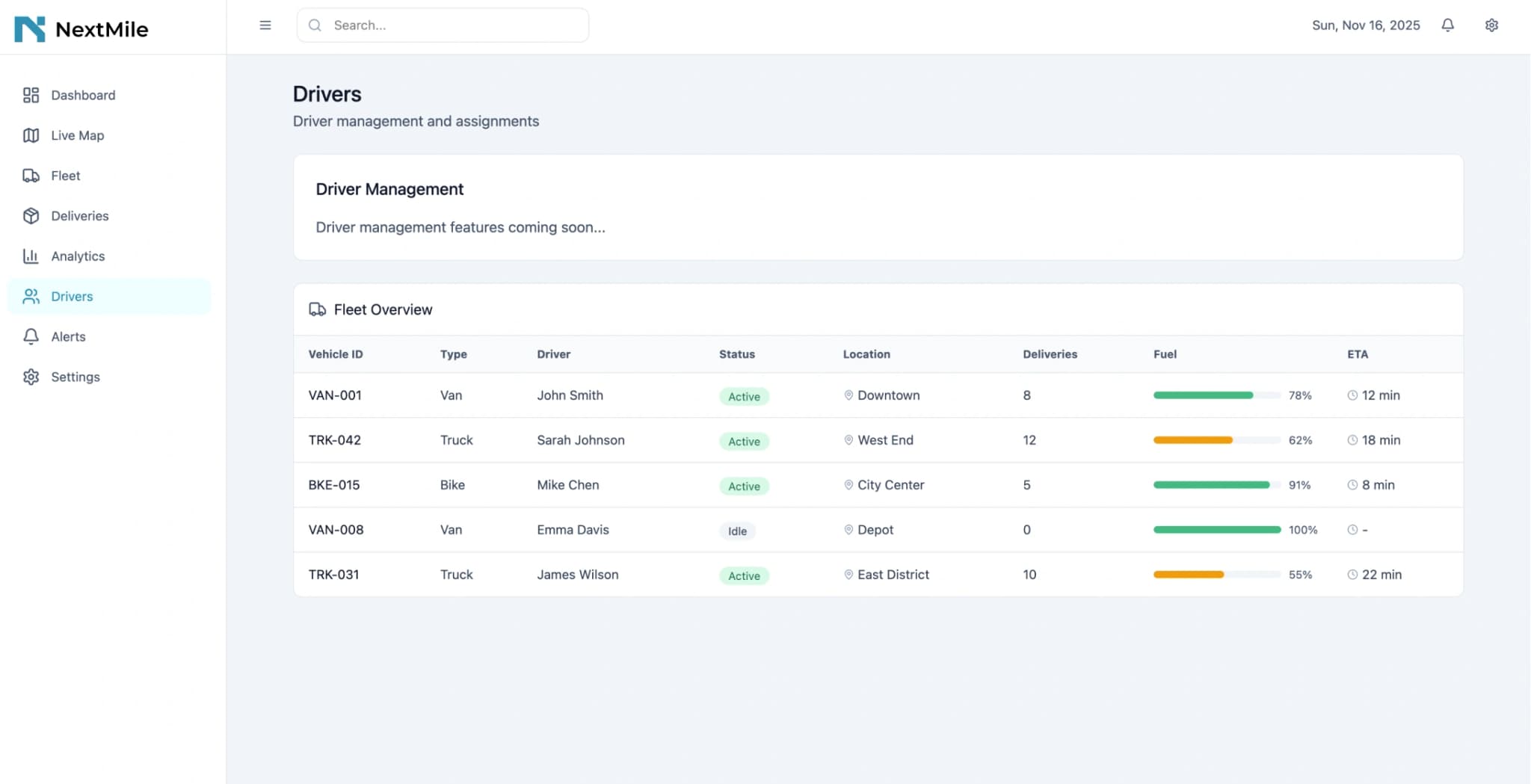
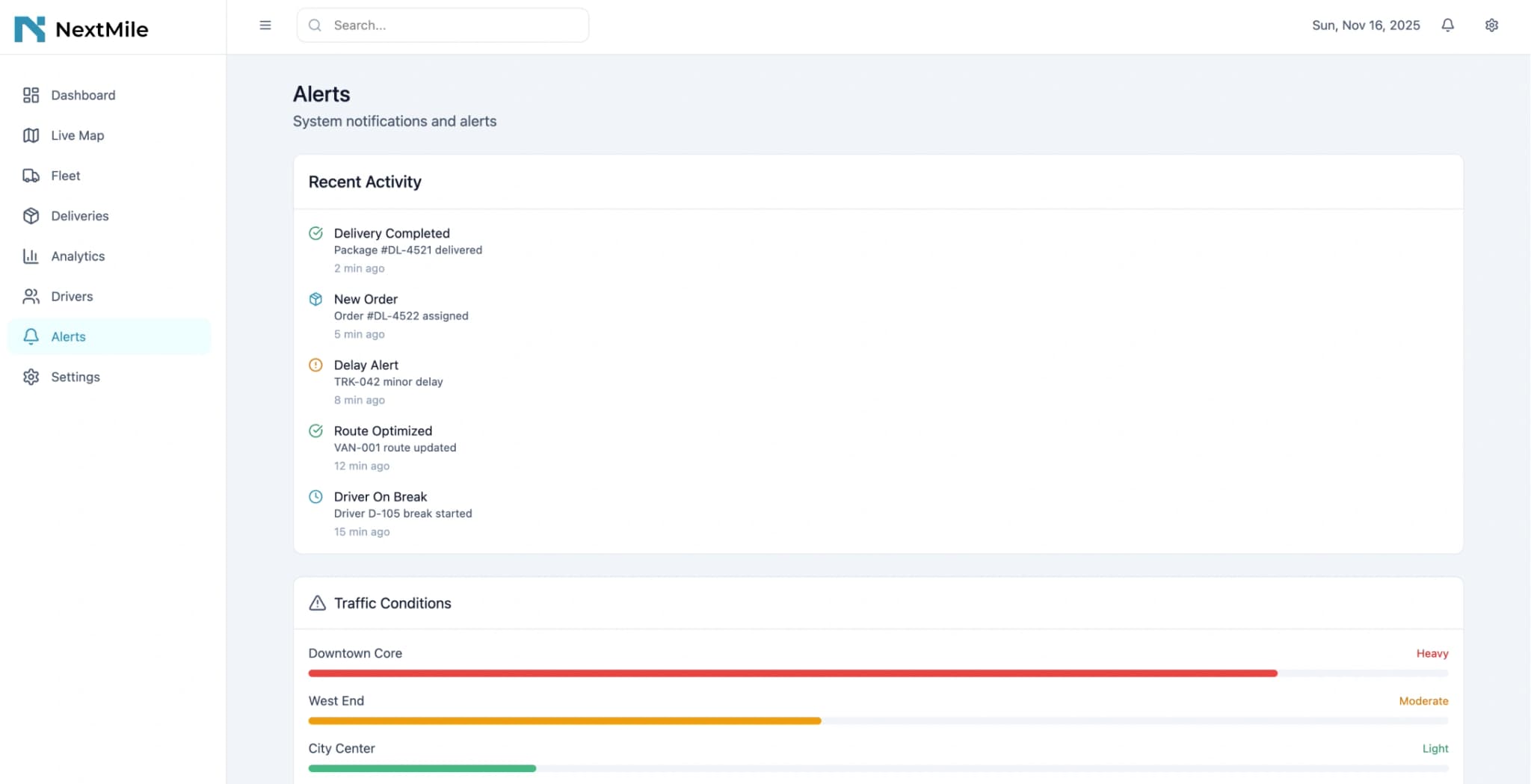
Project Overview
Legacy delivery processes depended on scattered systems that led to a 23 percent increase in delivery delays and limited customer awareness within transportation networks using multiple modes of transportation.
A cohesive logistics system was put into place featuring up-to-the-minute tracking capabilities and flexible route planning options, along with two-way communication channels to facilitate over 50k deliveries every day.
Modern Delivery System Complexity
Modern delivery systems are dealing with increasing complexity due to rising customer demands for deliveries like same-day and next-day services. The conventional logistics setups usually function by managing orders differently from planning routes or tracking fleets, communicating with customers distinctly.
This division results in gaps within the supply chain that cause:
- Inefficiencies in resource distribution
- Missed delivery times
- Unsatisfactory customer interactions
The difficulty increases when dealing with changing factors like traffic flow changes and weather conditions, as unexpected occurrences such as vehicle malfunctions and sudden alterations to orders can cause significant disruptions.
Communication Challenges
Communication Challenges
Delivery operations can face delays and mistakes due to manual coordination between dispatchers and drivers relying on phone conversations and radio exchanges. Furthermore, customer expectations for immediate access to their shipment details necessitates prompt automatic updates on delivery statuses.
Business Impact of Inefficiencies
To succeed in the fleet business world requires juggling goals like cutting costs without sacrificing service excellence and staying on top of regulations while adjusting to changes in demand dynamics. This significantly impacts overall efficiency and effectiveness of last-mile delivery services due to its substantial share of shipping expenses, typically ranging from 40 to 60%.
System Integration Problems
Delivery companies encountered challenges due to outdated systems and manual procedures that were not integrated effectively with each other:
- Route planning depended on fixed algorithms unable to adjust to real-time situations
- Less than optimal assignments for drivers and longer delivery timeframes
- Dispatchers lacked a comprehensive view of the fleet at their disposal
- Challenging to address delays or issues promptly and efficiently
Customer Service Issues
The customer service faced issues due to missing information gaps leading to:
- Inaccurate delivery estimates
- Lack of notifications regarding delays
- Customer frustration and increased call volume
- Particular problems with urgent deliveries
Solution Implementation Results
Delivery Reliability Improvements
Improved delivery reliability by reducing late deliveries by 67% utilizing smart routing and real-time traffic updates to enhance customer satisfaction and minimize penalties incurred due to delays.
Transform Your Delivery Operations
Discover how integrated logistics systems can revolutionize your delivery performance and customer satisfaction.
Customer Experience Enhancements
Customer Experience Enhancements
Implemented strategies to improve customer experience by sending delivery notifications and providing estimated time of arrivals (ETAs). This led to:
- 54 percent reduction in customer service inquiries
- Boosted satisfaction ratings from 3.2 to 4.7 out of five
Fleet Optimization Results
Increased the usage of fleet vehicles from 72 percent to 91 percent by implementing:
- Load balancing techniques
- Optimized driver-to-vehicle alignments
Compliance and Efficiency Gains
Automated tracking of Hours of Service and delivery documentation has significantly:
- Cut down audit preparation time by 89%
- Removed violations in compliance and reporting processes
- Enabled scalable growth in volume without infrastructure adjustments
Technical Architecture
Platform Design Philosophy
The platform's architecture focuses on using event-triggered microservices to manage logistics tasks while keeping data synchronized in real-time effectively. The main strategy involves separating the management of orders with state from the optimization services without state to allow for scaling and isolating faults.
Route Optimization Technology
The optimization of routes uses machine learning models that have been trained based on:
- Historical delivery trends
- Current traffic information
- Driver performance data
- Delivery schedules and vehicle capacity
- Driver hours and fuel efficiency
Real-Time Tracking System
Real-time tracking utilizes:
- GPS technology with geofencing
- Mobile app check-ins
- Push notifications and SMS alerts
- In-app messaging among all involved parties
This helps streamline coordination efforts and quicken response times.
System Components
Core Services
System Architecture Components
| Service | Technology | Function |
|---|---|---|
| Order Management | PostgreSQL, Redis | Customer info, delivery scheduling |
| Real-Time Tracking | InfluxDB, WebSocket | GPS coordinates, delivery events |
| Communication Gateway | Provider APIs | Push notifications, emails, delivery confirmations |
Mobile Applications
Mobile Applications
Native iOS and Android applications are developed to:
- Work without an internet connection
- Ensure data synchronization with the server
- Provide performance optimization for areas with varying network conditions
Web Dashboard
The dashboard for the web is built using React and is designed for operational teams to monitor fleets in real-time through data visualization and reporting tools.
Analytics Pipeline
The analytics pipeline processes event streams using Apache Spark to generate performance metrics and conduct analytics for business intelligence reporting purposes.
Security and Monitoring
Security Implementation
The security setup involves:
- OAuth 2 authentication for login security measures
- API rate limiting to control data access speeds
- Encrypted data transmission for privacy protection
- SOC 2 compliance standards
- Audit logs and role-based access controls through security audits
- Data retention policies following blockchain consulting industry guidelines
Observability Framework
Observability covers a range of monitoring tools:
- Jaeger for tracing
- ELK stack for centralized logging
- Custom dashboards tracking SLAs, error rates, and key business performance indicators (KPIs)
- Auto-scaling policies that dynamically adjust computing resources
Implementation Strategy
Development Approach
The project was developed using a step-by-step method that initially concentrated on tracking and communication functions during the MVP deployment phase before including advanced optimization features in later updates.
Deployment Strategy
The strategy for the environment involved:
- Creating development areas as well as staging and production clusters
- Blue-green deployment methods for seamless updates
- CI/CD pipeline with automated tests for code quality and security scans
Migration Strategy
The strategy for migrating the database involved:
- Using dual-write methods during transition phases
- Allowing for rollbacks while syncing data gracefully
- API versioning to facilitate smooth client transitions
Testing and Quality Assurance
Testing Methodology
The testing approach focused on:
- Integration testing for microservices interactions
- Load testing to simulate peak traffic conditions
- Chaos engineering to verify system resilience
- Mobile application testing across Android and iOS platforms
- Network condition simulation for comprehensive assessment
Risk Management
The company prioritized risk management by implementing:
- Automated backup systems for data center failures
- Circuit breakers to prevent widespread system collapses
- Manual intervention capabilities for crucial operational choices
- Staff training programs for effective tool utilization
Performance Results
Operational Improvements
The platform underwent a transformation that led to significant enhancements in efficiency and customer satisfaction metrics within the initial quarter of complete implementation.
Key Performance Metrics:
- On-time delivery percentage increased by 22 percentage points from 67% to 89%
- Customer interaction saw a boost with 78 percent of recipients monitoring their deliveries
- Satisfaction rating of 92 percent for delivery time accuracy
Cost Optimization
- Fuel costs reduced by 42 percent through optimized routing
- Driver behavior changes due to real-time fuel-efficient route suggestions
- Environmental and cost advantages creating a positive feedback cycle
Technical Challenges and Solutions
Real-Time Optimization Balance
Balancing complexity and response time constraints is crucial for real-time optimization processes. The system evolved from slow but perfect algorithms to current "good enough" heuristics that deliver practical solutions quickly.
Optimization Results
Current system achieves 85 percent optimization within 23 seconds compared to perfect solutions taking over 3 minutes in production.
Offline Functionality
Offline functionality in applications has been crucial in regions with poor cellular service coverage, allowing drivers to:
- Retrieve route data and customer information
- Confirm deliveries without active network connection
- Handle conflicts smoothly once connectivity is restored
User Experience Design
The way a design looks can affect how easily people of various tech backgrounds use it while driving. Easy-to-follow steps with visuals and spoken directions helped:
- Cut training time from 14 days to 3 days
- Make data collection more precise
Integration Complexity
More work was needed for integrating with legacy fleet management systems than originally expected. Legacy systems often lack modern integration features and require:
- Custom middleware development
- Data transformation layers
- Extended API development
Peak Load Management
During peak times like Black Friday and holidays when traffic surges by 400%, it's crucial to have scaling strategies based on predictive signals rather than reactive auto-scaling triggers.
Data Quality Maintenance
Maintaining data quality is crucial when dealing with large amounts of information. Issues like unusual GPS coordinates and duplicated delivery confirmations can snowball with thousands of transactions daily.
Driver Satisfaction
Automated processes for cleaning and verifying data play a crucial role in ensuring the integrity of analytical efforts.
Driver Satisfaction Balance
Excessive optimization could hinder driver satisfaction. Past routing systems focused primarily on fuel economy rather than considering driver preferences and necessary break times, resulting in resistance from delivery teams. The current solution addresses:
- Driver comfort and familiarity with routes
- Comprehensive approach balancing multiple factors
- Driver preference integration
Technology Stack Summary
Data Storage:
- PostgreSQL for transactional data
- InfluxDB for time series telemetry
Optimization Engine:
- Python-based optimization engine utilizing the OR Tools library
CI/CD:
- GitLab pipelines for automated testing and deployment workflows
Project Results
- 67% reduction in late deliveries
- 89% on-time delivery rate achieved
- 4.7/5 customer satisfaction rating
- 42% fuel cost reduction
- 91% fleet utilization rate
Key Performance Metrics
Late Delivery Reduction
Reduction in late deliveries
On-time Delivery
On-time delivery rate
Customer Satisfaction
Customer satisfaction rating
Fleet Utilization
Fleet vehicle utilization


